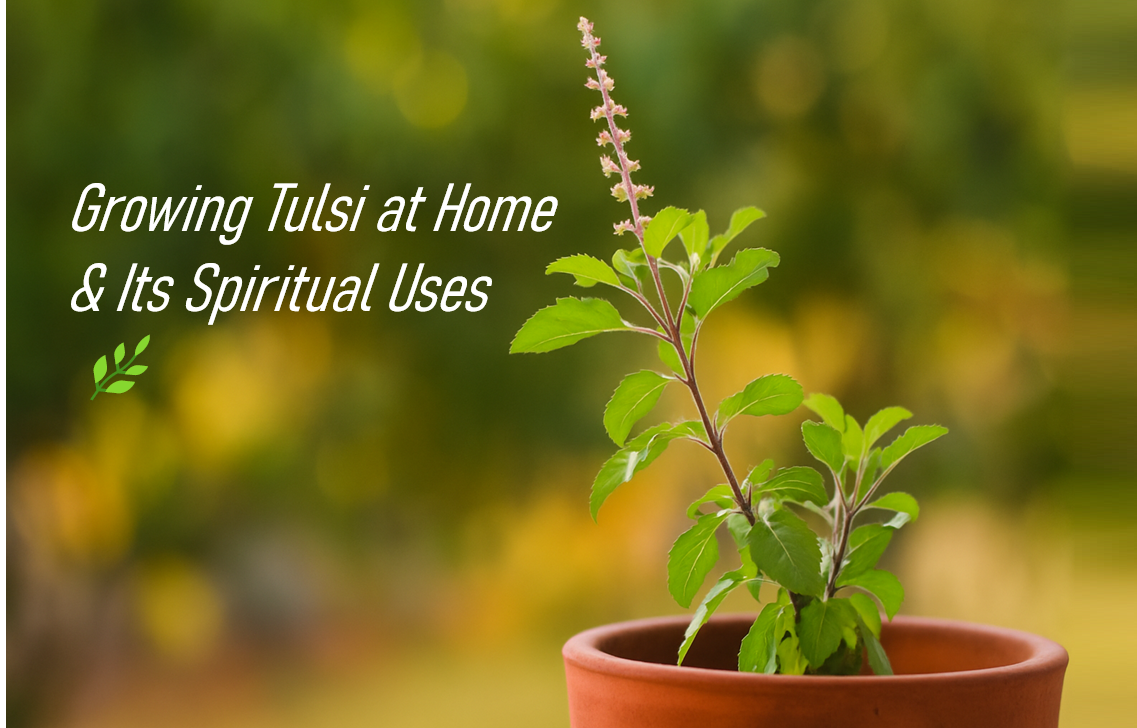Tulsi, also known as Holy Basil, is not just a medicinal plant—it is a divine herb revered in every Sanatan household. Known as “Vrinda” or “Haripriya,” Tulsi is deeply intertwined with Vedic culture and daily rituals. It’s believed that a home with Tulsi invites positive energy, spiritual growth, and divine protection.
In this blog, you’ll learn how to grow Tulsi at home and understand the powerful spiritual significance of Tulsi in your daily life.
🌱 How to Grow Tulsi at Home
1. 🪴 Choosing the Right Variety
There are three common varieties of Tulsi:
- Rama Tulsi (green leaves) – sweet aroma and cooling
- Krishna Tulsi (purple leaves) – stronger taste and medicinal power
- Vana Tulsi (wild) – grows in forests, highly potent in Ayurveda
For daily puja and home growing, Rama Tulsi is most commonly used.
2. 🌤️ Best Place to Plant Tulsi
Tulsi loves sunlight and fresh air. Ideally, place your Tulsi plant in:
- The north, northeast, or east direction of your home
- A spot where it gets 4–6 hours of sunlight daily
- Near your home temple, balcony, or courtyard
Avoid keeping it in bathrooms, bedrooms, or very shaded areas.
3. 🌱 Potting & Soil
Use a medium-sized clay or terracotta pot with good drainage. The soil should be:
- Loamy and well-drained
- Enriched with cow dung manure or organic compost
- pH between 6–7.5
You can mix garden soil + compost + sand in equal ratio for best growth.
4. 💧 Watering the Tulsi Plant
- Water Tulsi early morning (preferably after your bath).
- Avoid watering in the evening or night.
- Do not overwater — check that the top soil is dry before watering again.
5. 🧹 Daily Care and Do’s
- Remove dried leaves and flowers regularly.
- Clean the pot area often, as Tulsi is considered sacred.
- Never touch the plant with unclean hands or during menstruation.
- Offer water daily (Arghya), and light a diya beside it in the morning or evening.
6. 🌸 Seasonal Care Tips
- In monsoon, prevent waterlogging.
- In winter, bring Tulsi indoors if it gets too cold.
- Regularly pinch the flower buds to encourage leaf growth.
🕉️ Spiritual Uses & Significance of Tulsi
1. 🙏 Tulsi as the Sacred Wife of Vishnu
In Sanatan Dharma, Tulsi is believed to be the incarnation of Goddess Vrinda, a devotee of Vishnu. She is worshipped as Tulsi Devi, and rituals like Tulsi Vivah (symbolic marriage to Lord Vishnu) are celebrated during Kartik month.
“Tulsi, beloved of Hari, remover of sins, purifier of the body, grant me your divine grace.”
2. 🌬️ Purifies Aura and Air
Tulsi releases oxygen even at night, unlike most plants. It purifies the surroundings of:
- Bacteria and viruses
- Negative energies
- Unwanted emotional vibrations
It’s said that chanting or meditating near Tulsi enhances sattva and spiritual vibrations.
3. 🧘♀️ Used in Mantra Jap and Mala
Tulsi wood is used to make jap malas for chanting mantras like:
- Hare Krishna Maha Mantra
- Om Namo Bhagavate Vasudevaya
- Om Namah Shivaya
Tulsi beads are believed to amplify the spiritual merit (punya) of mantra chanting.
4. 🩺 Medicinal and Ritual Use
Tulsi is widely used in:
- Tulsi tea for cold, cough, and immunity
- Holy water (Charanamrit) in temples
- Fire offerings (Havan) as a purifier
Tulsi leaves should never be chewed, only swallowed or offered respectfully.
5. 🌞 Daily Rituals Involving Tulsi
- Offer water in a copper vessel to Tulsi every morning
- Light a diya with sesame or cow ghee near Tulsi in the evening
- Circumambulate (Parikrama) the plant 3 or 11 times with devotion
Avoid plucking leaves on Sundays, Ekadashi, or at night.
🏡 Final Thoughts: Make Your Home a Temple
Having a Tulsi plant at home is like inviting Goddess Lakshmi and Lord Vishnu into your house. With minimal care and full devotion, Tulsi becomes your daily reminder to live a life of purity, compassion, and inner peace.
By growing Tulsi and worshipping it daily, you don’t just beautify your space—you create a living spiritual sanctuary.

